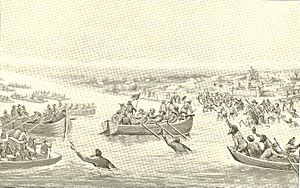Leonard Helm facts for kids
Quick facts for kids
Leonard Helm
|
|
|---|---|
| Born | around 1720 |
| Died | around June 4, 1782 (aged 62-61) Jefferson County, Virginia (now Kentucky)
|
| Nationality | American |
| Occupation | Early pioneer of Kentucky |
| Known for | Virginia officer during the American Revolutionary War |
Leonard Helm was an important early pioneer in Kentucky. He was also a Virginia officer during the American Revolutionary War. Born around 1720 in Fauquier County, Virginia, he died around June 4, 1782. He was fighting Native American allies of the British troops in what is now Jefferson County, Kentucky.
Contents
Leonard Helm and the Illinois Campaign
Leonard Helm was chosen to be a captain by George Rogers Clark. Clark asked him to gather and lead a group of soldiers from Virginia. On January 2, 1778, Governor Patrick Henry of Virginia gave Clark permission to create a regiment. He also gave Clark secret orders to attack British forces and their allies on Virginia's frontier.
Captain Helm had worked with Clark before during Lord Dunmore's War. He also knew a lot about Kentucky. Because of this, he was given command of one of the first four companies in Clark's new regiment. Captain Helm found soldiers from the Virginia militia in Prince William and Fauquier Counties. This group later became known as the Illinois Regiment. They took part in the Northwest Campaign.
Capturing Kaskaskia and Cahokia
Clark and his soldiers captured Kaskaskia, Illinois on July 4, 1778. They then captured Cahokia, Illinois on July 6, 1778. During the capture of Kaskaskia, Clark divided his forces. He led one half, and Captain Helm led the other. They had a series of peaceful victories. Helm's group even reached as far as Fort Ouiatenon.
Captain Helm at Vincennes
The town of Vincennes decided to support the Americans. This happened after Father Gibault encouraged them. Captain Helm was sent to take command of Fort Sackville. This fort was later renamed Fort Patrick Henry. He had a group of local French-speaking militiamen and 20 soldiers from Virginia. He also asked for and received help from the local Piankeshaw tribe. Their chief, known as Young Tobacco, was especially helpful.
British Recapture of Fort Sackville
The British took back Fort Sackville on December 17, 1778. This happened after Helm's local militia left. He had too few men to fight back. When the British got very close to the fort, Captain Helm opened the gate. He pointed a cannon at the British soldiers. He held an artillery match in one hand and a bottle of whiskey in the other.
He invited Lieutenant Colonel Hamilton to share whiskey and talk like gentlemen. Helm knew the British did not fully understand how few men he had. So, he demanded and received good terms for his surrender. Lieutenant Colonel Hamilton was surprised later to find only three people inside the fort. But he still honored his agreement.
Clark's Siege of Fort Sackville
When Colonel Clark heard about the surrender, he marched his force through icy winter weather. They then surrounded Fort Sackville. Captain Helm was a prisoner inside Fort Sackville during this time. Clark wrote in his memoir that Helm "amused himself very much during the siege, and, I believe, did much damage."
Helm came with the British to the negotiations on February 24 to end the siege. He tried to get Clark to agree to less harsh surrender terms. Clark said that Helm could not negotiate because he was a British prisoner. At that point, Hamilton released Helm. Clark then refused to let Helm join his side. He told Helm to go back to Fort Sackville and "await his fate." Hamilton surrendered on February 25, 1779. Fort Sackville was again renamed Fort Patrick Henry.
Wabash River Expedition
On March 5, 1779, Helm led a small group of 3 boats and 50 men. They went up the Wabash River from Vincennes. They captured a fleet of 7 boats and 40 prisoners. Among the prisoners was 'Dejeane, Grand Judge of Detroit'. They also captured supplies and trade goods. These were meant to help Hamilton at Fort Sackville.
This event happened just west of Pointe Coupee, Indiana. People in the area call it the westernmost naval battle of the American Revolution. However, George Rogers Clark's memoir describes it differently:
March 5th, Captain Helm, Majors Bosseron and Legras, returned from their journey up the river with great success. They came up with the enemy in the night, discerning their fires at a distance; waited until all was quiet; surrounded and took the whole prisoners, without the firing of a gun. Those (British) gentlemen were off their guard, and so little apprehensive of an enemy in that part of the world that they could hardly persuade themselves that what they saw and heard was real. This was a valuable (prize) seven boats loaded with provisions and goods to a considerable amount.
Fort Nelson and Helm's Death
Clark later made Helm the commander of Fort Nelson. This fort was in what is now Louisville, Kentucky. Captain Helm was killed while he was serving as the commander of this fort.
Helm had sold some of his land for continental currency. He believed its value would go up. Instead, the continental dollar became almost worthless. Helm died with very little money. His only personal belongings were his clothes. Many years later, his family received 4,666 acres (19 km²) of land from Virginia. This was for his service in the Illinois Regiment. Leonard Helm's service during the American Revolution meets the requirements for membership in the Society of the Cincinnati.


